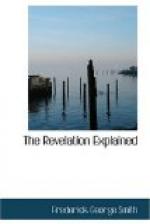The great secret of the early success of the reformers was their appeal from the decisions of councils and regulations of men to the Word of God. So long as the Word and Spirit of God were allowed their proper place as the Governors of God’s people, the work was a spiritual blessing. But this happy state of affairs did not long continue. Within a few years the followers of the reformers were divided into hostile sects and began to oppose and persecute each other. Luther denounced Zwingle as a heretic, and “the Calvinists would have no dealings with the Lutherans.” The first Protestant creed was the Augsburg Confession (1530). This date marks an important epoch. From this time the people began to lose sight of the Word and Spirit of God as their Governors and to turn to the disciplines of their sects, which they upheld by every means possible. Thus we find Calvin at Geneva consenting to the burning of Servetus, because of a difference of religious views; and in England the Anglican Protestants waged the most bitter, cruel, and relentless war not only against Catholics, but against all Protestants who refused to conform to the Established Church. The Protestants placed armies in the field and fought for their creeds, as during the Thirty Years’ War in Germany and the long period of the Hugenot wars in France. The real work of the Reformation, the promulgation of so much of the truth of the Bible, was an inestimable blessing to the world; but the rise of Protestantism (organized sectism) in 1530 introduced another period of apostasy as distinct in many of its features as was that of Romanism before it. The historian D’Aubigne recognizes an important change at this period. He says:
“The first two books of this volume contain the most important epochs of the Reformation—the Protest of Spires, and the Confession of Augsburg.... I determined on bringing the reformation of Germany and German Switzerland to the decisive epochs of 1530 and 1531. The history of the Reformation, properly so-called, is then in my opinion almost complete in those countries. The work of faith has there attained its apogee: that of conferences, of interims, of diplomacy begins.... The movement of the Sixteenth Century has there made its effort. I said from the very first, It is the history of the Reformation and not of Protestantism that I am relating.” Preface to Vol. V.
11. And I beheld another
beast coming up out of the earth; and
he had two horns like a lamb,
and he spake as a dragon.
12. And he exerciseth
all the power of the first beast before
him, and causeth the earth
and them which dwell therein to
worship the first beast, whose
deadly wound was healed.
13. And he doeth great
wonders, so that he maketh fire come down
from heaven on the earth in
the sight of men,




